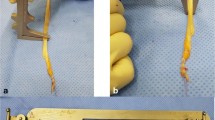Abstract
Purpose
To predict adequacy of semitendinosus (ST) graft dimension for ACLR from anthropometric measures.
Introduction
Single tendon harvest for autograft hamstring ACLR could be beneficial to limit donor site morbidity; however, concerns for reconstruction failure based upon inadequate graft size may limit this surgical technique.
Methodology
To predict adequacy, prospectively, 108 patients who underwent ACLR by hamstring graft (STG graft) were enrolled for the study. Mean age was 33.028 years ± 9.539 SD (14–59) with 88 males and 20 females. Anthropometric measurements (height, weight, BMI, thigh and total limb length) and intraoperative data (graft dimensions and bone tunnel measurements) were collected for analysis. Semitendinosus graft can be used as 3-strand (ST3) or 4-strand (ST4) graft. Adequacy criteria for ST3 and ST4 graft dimensions were determined from data analysis. SPSS (v.17) Pearson’s correlation coefficient and ROC curves were used for statistical analyses.
Results
A total of 74 out of 108 patients (68.52 %) had adequate graft dimensions for ST3 reconstruction. Height equal or greater than 158 cm was predictive of adequate graft for ST3 reconstruction. Only 23 patients (21.3 %) had adequate graft dimensions for ST4 reconstruction. Height equal or greater than 170 cm was predictive of adequate graft for ST4 reconstruction. Height variable had the highest ROC curve area of 0.840 and 0.910 for both ST3 graft and ST4 graft, respectively. Hence, height was used as best predictor to determine adequacy of the graft.
Conclusion
Height can be predictive of adequate graft for single tendon ACL reconstruction.






Similar content being viewed by others
References
Marcacci M, Zaffagnini S, Iacono F et al (2003) Intra- and extraarticular anterior cruciate ligament reconstruction utilizing autogeneous semitendinosus and gracilis tendons: 5-Year clinical results. Knee Surg Sports Traumatol Arthrosc 11(1):2–8
Howell SM, Deutsch ML (1999) Comparison of endoscopic and two-incision techniques for reconstructing a torn anterior cruciate ligament using hamstring tendons. Arthroscopy 15(6):594–606
Beynnon BD, Johnson RJ, Fleming BC et al (2002) Anterior cruciate ligament replacement: comparison of bonepatellar tendon-bone grafts with two-strand hamstring grafts: a prospective, randomized study. J Bone Joint Surg 84(9):1503–1513
Gobbi A, Tuy B, Panuncialman I, Mahajan S (2003) Quadrupled bone-semitendinosus anterior cruciate ligament reconstruction: a clinical investigation in a group of athletes. Arthroscopy 19(7):691–699
Cooley V, Deffner K, Rosenberg T (2001) Quadrupled semitendinosus anterior cruciate ligament reconstruction: 5-Year results in patients without meniscus loss. Arthroscopy 17(8):795–800
Goradia V, Grana W (2001) A comparison of outcomes at 2 to 6 years after acute and chronic anterior cruciate ligament reconstructions using hamstring tendon grafts. Arthroscopy 17(4):383–392
Tashiro T, Kurosawa H, Kawakami A, Hikita A, Fukui N (2003) Influence of medial hamstring tendon harvest on knee flexor strength after anterior cruciate ligament reconstruction. A detailed evaluation with comparison of single-and double-tendon harvest. Am J Sports Med 31(4):522–529
Gobbi A (2010) Single versus double hamstring tendon harvest for ACL reconstruction. Sports Med Arthrosc 18(1):15–19
Segawa H, Omori G, Koga Y et al (2002) Rotational muscle strength of the limb in anterior cruciate ligament reconstruction using semitendinosus and gracilis tendon. Arthroscopy 18(2):177–182
Ardern CL, Webster KE, Taylor NF, Feller JA (2010) Hamstring strength recovery after hamstring tendon harvest for anterior cruciate ligament reconstruction: a comparison between graft types. Arthroscopy 26(4):462–469
Tuman JM, Diduch DR, Rubino LJ, Baumfeld JA, Nguyen HS, Hart JM (2007) Predictors for hamstring graft diameter in anterior cruciate ligament reconstruction. Am J Sports Med 35:1945–1949
Treme G, Diduch DR, Billante MJ, Miller MD, Hart JM (2008) Hamstring graft size prediction: a prospective clinical evaluation. Am J Sports Med 36:2204–2209
Schwartzberg R, Burkhart B, Lariviere C (2008) Prediction of hamstring tendon autograft diameter and length for anterior cruciate ligament reconstruction. Am J Orthop 37:157–159
Barenius B, Webster WK, McClelland J, Feller J (2013) Hamstring tendon anterior cruciate ligament reconstruction: does gracilis tendon harvest matter? Int Orthop 37:207–212
Noyes FR, Butler DL, Grood ES, Zernicke RF, Hefzy MS (1984) Biomechanical analysis of human ligament grafts used in kneeligament repairs and reconstructions. J Bone Joint Surg Am 66(3):344–352
Grood ES, Walz-Hasselfeld KA, Holden JP et al (1992) The correlation between anterior-posterior translation and crosssectional area of anterior cruciate ligament reconstructions. J Orthop Res 10(6):878–885
Hamada M, Shino K, Horibe S, Mitsuoka T, Toritsuka Y, Nakamura N (2005) Changes in cross-sectional area of hamstring anterior cruciate ligament grafts as a function of time following transplantation. Arthroscopy 21(8):917–922
Gobbi A (2007) Double bundle ACL reconstruction using only the semitendinosus. ISAKOS Current concepts, Winter
Gobbi A, Francisco R (2005) Quadruple semitendinosus tendon for anterior cruciate ligament reconstruction. Tech Orthop 20(3):203–206
Singhal MC, Johnson DL, Fites BS (2005) Fixation devices in ACL surgery: what do I need to know? Orthopedics 28(9):920–4
Brand J Jr, Weiler A, Caborn DN, Brown CH Jr, Johnson DL (2000) Graft fixation in cruciate ligament reconstruction. Am J Sports Med 28:761–774
Prodromos C (2007) The anterior cruciate ligament reconstruction and basic science. 2ST/2Gr, 4ST, and 3ST/2Gr techniques: deciding which hamstring configuration to use. Saunders, New York, pp 110–114
Conflict of interest
No conflict of interest.
Author information
Authors and Affiliations
Corresponding author
Rights and permissions
About this article
Cite this article
Sundararajan, S.R., Rajagopalakrishnan, R. & Rajasekaran, S. Is height the best predictor for adequacy of semitendinosus-alone anterior cruciate ligament reconstruction? A study of hamstring graft dimensions and anthropometric measurements. International Orthopaedics (SICOT) 40, 1025–1031 (2016). https://doi.org/10.1007/s00264-015-2882-8
Received:
Accepted:
Published:
Issue Date:
DOI: https://doi.org/10.1007/s00264-015-2882-8




